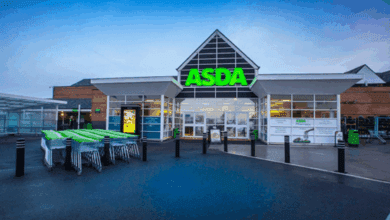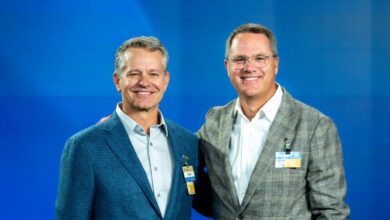Register to get 1 free article
Reveal the article below by registering for our email newsletter.
Want unlimited access? View Plans
Already have an account? Sign in
Retail media has emerged from the periphery of marketing strategy into one of the most dynamic and rapidly evolving sectors in modern commerce. At the centre of that transformation is a growing recognition that first-party data—properly governed, connected, and activated—offers retailers and brands unprecedented opportunities to collaborate, personalise, and grow. Few people have had a front-row seat to that evolution quite like Hugh Stevens, Managing Director at LiveRamp.
“These have been really exciting… three or four years and a long way to go, I think, in how that matures,” Stevens says. With a career that started in selling boxed software to the public sector, then moving into direct marketing and data strategy, his trajectory mirrors the industry’s own data-driven awakening.
A Career at the Crossroads of Data and Media
Stevens began his journey at Map Info, before moving into the data and marketing space—first with third-party data, then transitioning into first-party data strategy. His time at Acxiom was pivotal. “We then were one of the first companies to work with Meta… on their marketplace products, so bringing third party data into the Meta environment,” he recalls.
Later, at Dentsu following its acquisition of Merkle, Stevens explored how data and media could combine. “That was a really interesting move to think about how… the customer data and the media world really came together,” he says.
Today, at LiveRamp, his focus is retail media. “Retail media, I think, has been the big kind of topic for us over the last… three or four years,” he explains. His client list includes household names in UK retail: Boots, Tesco, and Co-op—all seeking to extract more value from their data assets.
Retail Media: An Ecosystem of Opportunity
At its core, LiveRamp enables brands to connect their first-party data with paid media environments. “We still enable brands to connect their data into those media channels in order to deliver greater effectiveness and efficiencies within… media,” Stevens explains. But the company’s role has expanded significantly.
“We’ve kind of evolved our narrative,” he says. “Through the acquisition of a company called Abou last year, we’ve now really… leant into the clean room space.” That move has allowed LiveRamp to support data collaboration in a secure, privacy-compliant environment.
“Clean room really is… about being a safe environment where… businesses can… collaborate across data sets,” Stevens explains. Instead of moving data between organisations—often fraught with compliance and privacy risks—brands and retailers can now query shared data safely. “That moment of trust between businesses… to say, right, okay. Well, I’m going to allow you to use this data in this way with these controls.”
A Closed Loop from Ad Impression to In-Store Sale
One of the most compelling examples of this collaboration is a recent project between Boots, Criteo, and LiveRamp. “What we launched with Boots and Criteo… is really taking what Criteo do… serving targeted advertising within the Boots website… and [asking] what impact does this have on in-store and bricks and mortar sales?”
Traditionally, there was no simple way to connect a digital ad served online to an in-store transaction. But LiveRamp helped close that loop. “We worked really closely with them and Boots to work out how could we help them connect the in-store transaction against the… Boots Advantage Card… to the online impression.”
The result? For the first time, Boots could attribute in-store sales to digital ads with precision. “It’s an example which has actually been a catalyst to some other thinking around all sorts of other touchpoints and media,” Stevens says.
Data as Strategic Asset, Not Just Advertising Tool
As brands and retailers become more sophisticated, the data conversation is no longer confined to advertising performance. “We’re much more enabling the processing as a trusted party to… illustrate an additional benefit to something that’s already taking place,” Stevens explains.
Retailers like Tesco and Sainsbury’s, long known for their loyalty schemes, are now considering how to consolidate data usage across teams and capabilities. “They might have had previously… multiple partner leads… whereas now… trying to think about it as one cohesive… GBP with… those brands,” he notes.
For retailers just entering the space, Stevens emphasises four fundamentals: permissions, infrastructure, partnerships, and proposition.
“You’ve got to have the right permissions on your data… Infrastructure is key… both from the point of view of technology, but equally… the marketing org… does require some different skills.”
Retailers also need to make their data assets easy to integrate into brands’ existing ecosystems. “They just want to have… the ability to make better decisions and then… execute them on a large scale,” he says. That means acting like a publisher—selling advertising on their own websites and in-store environments.
Rethinking Scale and Specialisation
Not every retailer has the scale of a Boots or Tesco. Stevens is clear that success doesn’t depend solely on size. “It’s not necessarily all about always about being a smaller retailer. It’s about… how much data do you have… what scale can you generate for the brand… what is your USP?”
Some are choosing to outsource retail media operations. “We’ve got some clients… who have sort of outsourced that and said… we’re going to go and work with a partner to do that.”
He believes the future could include multi-retailer collaborations. “Where we may see… a capability where multiple retailers data could be queried through a single lens… [or] a grocery retailer partnering with a health and beauty retailer.”
Collaboration and Capability: Picking the Right Partners
At the heart of it all is collaboration. “Baked into our core is collaboration,” Stevens says. “Wherever possible being… clear and upfront with the retailer about… what value we’re going to help them drive.”
That includes bridging skill gaps. “Do I buy or build with technology?… Do I… hire formally or do I go and… partner with someone?”
Smaller retailers, in particular, may benefit from tapping into a “brain trust of capability” rather than trying to hire and retain scarce talent internally.
Ultimately, it’s about trust, alignment, and capability. “Partnerships are all got to be about collaboration… it starts with your… brands or your JBPs. And then… it’s about how you service that JVP.”
Building Teams That Speak Brand and Data
Success also depends on the right people. “Typically there’s a figurehead… who’s got a lot of… background and knowledge in the retail space,” Stevens explains.
But retail media teams also need to speak the languages of both brands and media. “You need people who are able to talk brand language, you need people who are able to talk media language as well.”
With demand shifting from tactical to strategic, data-savvy leaders are essential. “We’ve moved from… executing a media campaign to thinking about how strategically does data play a role within a brand.”
This requires “data strategy… brand strategy… salespeople… and [people who] navigate the complexities of your own… business.”
A Measured Future
Measurement is another area Stevens expects to evolve. “Retailers have got an opportunity to also show… what a longer term relationship with them is doing for a brand,” he says.
Instead of focusing solely on short-term campaign lift, brands want clarity on the “accumulative effect” of long-term partnerships.
“Ultimately, I think the brand will want to see… the number of products that are able to shift off the shelf, increasing across the board,” he says.
Stevens believes retail media will become more natively embedded in brand planning. “It will become a strong data point in media planning… even if the execution isn’t directly against… a member of a specific loyalty card base.”
From Store Screens to Strategic Planning
The omnichannel view continues to expand. LiveRamp is already helping clients optimise in-store screen placements based on audience data. “We can actually take an individual level audience and go… what stores have a highest propensity… to serve the right advert to the right audience at the right time.”
It’s not just flashing screens, either. Stevens recalls visiting a retailer in Europe using “smaller, impactful, messaging at specific points of the… store,” to achieve more subtle but targeted messaging.
As the media world integrates further with retail infrastructure, the future of retail media seems poised to influence not only media spend but also store layouts, product placement, and long-term brand partnerships.
Brands That Lead With Values
For Stevens personally, the brands that impress most are those with a clear sense of ethics and purpose. “The brands like Finisterre and Patagonia for me are absolutely… what I look for.”
“We are absolutely looking at… the ethics of the brand, the fabrics they use, whether it’s recycled… That’s what we are… interested in when we’re buying from.”
Even day-to-day household purchases reflect this mindset. “We… buy eco friendly… are they trying to remove plastic more in its entirety?”
And in a world of convenience, restraint matters. “Amazon is just too tempting to press a button and go… Just because it’s easy to buy, does it mean it? We should buy it.”
For Stevens, values, long-term thinking, and deep knowledge of one’s customers are what set great brands apart. “I love the fact that… a lot of these brands are now offering the ability to… get it fixed. You know, that sort of longevity of… products is really good.”
What Comes Next?
As retail media matures, the most important disruptions may not come from technology alone, but from a deeper integration of data, ethics, and collaboration into the fabric of how brands and retailers work together.
“Data is always quite a hot topic,” Stevens says. And as more companies move beyond basic activation toward deep strategic partnerships, those who align their teams, technology, and values will be best positioned to thrive.







